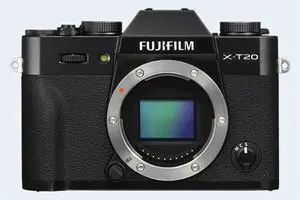Panasonic ZS200 vs Fujifilm X-T20
The Panasonic Lumix DC-ZS200 (called Panasonic TZ200 in some regions) and the Fujifilm X-T20 are two digital cameras that were announced, respectively, in February 2018 and January 2017. The ZS200 is a fixed lens compact, while the X-T20 is a mirrorless interchangeable lens camera. The cameras are based on an one-inch (ZS200) and an APS-C (X-T20) sensor. The Panasonic has a resolution of 20 megapixels, whereas the Fujifilm provides 24 MP.
Below is an overview of the main specs of the two cameras as a starting point for the comparison.

Check ZS200 price at
amazon.com

Check X-T20 offers at
ebay.com
Going beyond this snapshot of core features and characteristics, what are the differences between the Panasonic Lumix DC-ZS200 and the Fujifilm X-T20? Which one should you buy? Read on to find out how these two cameras compare with respect to their body size, their imaging sensors, their shooting features, their input-output connections, and their reception by expert reviewers.
Body comparison
The physical size and weight of the Panasonic ZS200 and the Fujifilm X-T20 are illustrated in the side-by-side display below. The two cameras are presented according to their relative size. Three consecutive views from the front, the top, and the rear side are shown. All size dimensions are rounded to the nearest millimeter.
Both cameras are available in two different colors (black, silver).
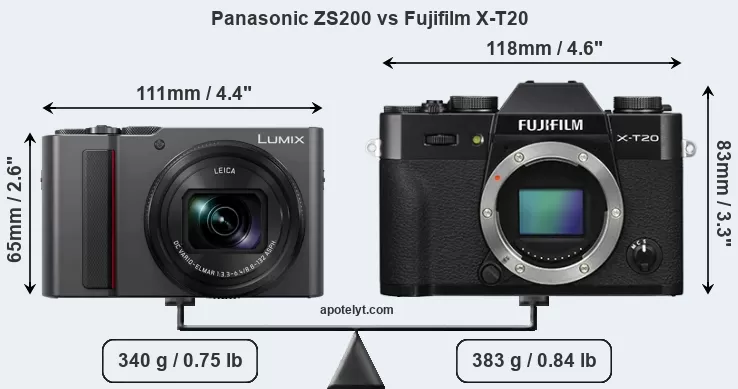
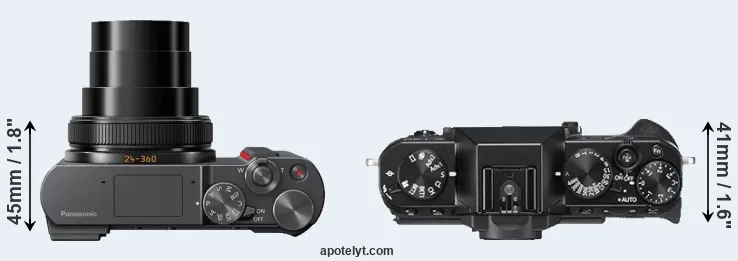
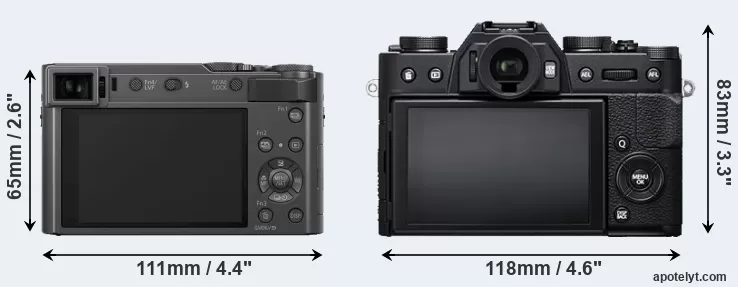
If the front view area (width x height) of the cameras is taken as an aggregate measure of their size, the Fujifilm X-T20 is notably larger (36 percent) than the Panasonic ZS200. In this context, it is worth noting that neither the ZS200 nor the X-T20 are weather-sealed.
The above size and weight comparisons are to some extent incomplete and possibly misleading, as the ZS200 has a lens built in, whereas the X-T20 is an interchangeable lens camera that requires a separate lens. Attaching the latter will add extra weight and bulk to the setup. You can compare the optics available for the X-T20 and their specifications in the Fujinon X Lens Catalog.
Concerning battery life, the ZS200 gets 370 shots out of its Panasonic DMW-BLG10 battery, while the X-T20 can take 350 images on a single charge of its Fujifilm NP-W126S power pack. The battery packs of both cameras can be charged via USB, which can be very convenient when travelling.
The adjacent table lists the principal physical characteristics of the two cameras alongside a wider set of alternatives. In case you want to display and compare another camera duo, you can use the CAM-parator app to select your camera combination among a large number of options.

| Camera Model |
Camera Width |
Camera Height |
Camera Depth |
Camera Weight |
Battery Life |
Weather Sealing |
Camera Launch |
Launch Price (USD) |
Street Price |
||
|---|---|---|---|---|---|---|---|---|---|---|---|
| 1. | Panasonic ZS200 | 111 mm | 65 mm | 45 mm | 340 g | 370 | n | Feb 2018 | 799 | amazon.com | |
| 2. | Fujifilm X-T20 | 118 mm | 83 mm | 41 mm | 383 g | 350 | n | Jan 2017 | 899 | ebay.com | |
| 3. | Canon G5 X | 112 mm | 76 mm | 44 mm | 353 g | 210 | n | Oct 2015 | 799 | ebay.com | |
| 4. | Canon G5 X Mark II | 111 mm | 61 mm | 46 mm | 340 g | 230 | n | Jul 2019 | 899 | ebay.com | |
| 5. | Canon G7 X | 103 mm | 60 mm | 40 mm | 304 g | 210 | n | Sep 2014 | 699 | ebay.com | |
| 6. | Canon G7 X Mark II | 106 mm | 61 mm | 42 mm | 319 g | 265 | n | Feb 2016 | 699 | ebay.com | |
| 7. | Canon G7 X Mark III | 105 mm | 61 mm | 41 mm | 304 g | 235 | n | Jul 2019 | 749 | amazon.com | |
| 8. | Fujifilm X-A5 | 117 mm | 68 mm | 40 mm | 361 g | 450 | n | Jan 2018 | 399 | ebay.com | |
| 9. | Fujifilm X-E3 | 121 mm | 74 mm | 43 mm | 337 g | 350 | n | Sep 2017 | 899 | ebay.com | |
| 10. | Fujifilm X-T10 | 118 mm | 83 mm | 41 mm | 381 g | 350 | n | May 2015 | 799 | ebay.com | |
| 11. | Fujifilm X-T30 | 118 mm | 83 mm | 47 mm | 383 g | 380 | n | Feb 2019 | 899 | ebay.com | |
| 12. | Fujifilm X-T100 | 121 mm | 83 mm | 47 mm | 448 g | 430 | n | May 2018 | 599 | ebay.com | |
| 13. | Panasonic FZ1000 | 137 mm | 99 mm | 131 mm | 831 g | 360 | n | Jun 2014 | 899 | ebay.com | |
| 14. | Panasonic FZ1000 II | 136 mm | 97 mm | 131 mm | 810 g | 350 | n | Feb 2019 | 899 | amazon.com | |
| 15. | Panasonic GX9 | 124 mm | 72 mm | 47 mm | 407 g | 260 | n | Feb 2018 | 849 | ebay.com | |
| 16. | Panasonic LX10 | 106 mm | 60 mm | 42 mm | 310 g | 260 | n | Sep 2016 | 699 | amazon.com | |
| 17. | Panasonic ZS100 | 111 mm | 65 mm | 44 mm | 312 g | 300 | n | Jan 2016 | 699 | ebay.com | |
| Note: Measurements and pricing do not include easily detachable parts, such as add-on or interchangeable lenses or optional viewfinders. | |||||||||||
Any camera decision will naturally be influenced heavily by the price. The retail prices at the time of the camera’s release place the model in the market relative to other models in the producer’s line-up and the competition. The ZS200 was launched at a lower price than the X-T20, despite having a lens built in. Usually, retail prices stay at first close to the launch price, but after several months, discounts become available. Later in the product cycle and, in particular, when the replacement model is about to appear, further discounting and stock clearance sales often push the camera price considerably down.
Sensor comparison
The imaging sensor is at the core of digital cameras and its size is one of the main determining factors of image quality. A large sensor will generally have larger individual pixels that offer better low-light sensitivity, provide wider dynamic range, and have richer color-depth than smaller pixels in a sensor of the same technological generation. Moreover, a large sensor camera will give the photographer more control over depth-of-field in the image and, thus, the ability to better isolate a subject from the background. On the downside, larger sensors tend to be more expensive and lead to bigger and heavier cameras and lenses.
Of the two cameras under consideration, the Panasonic ZS200 features an one-inch sensor and the Fujifilm X-T20 an APS-C sensor. The sensor area in the X-T20 is 217 percent bigger. As a result of these sensor size differences, the cameras have a format factor of, respectively, 2.7 and 1.5. Both cameras have a native aspect ratio (sensor width to sensor height) of 3:2.
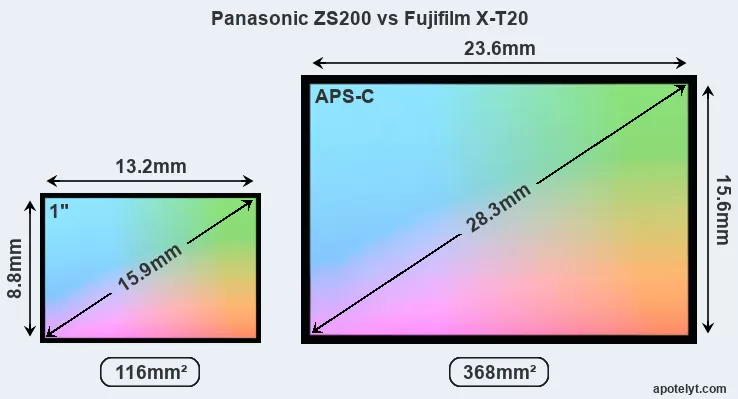
With 24MP, the X-T20 offers a higher resolution than the ZS200 (20MP), but the X-T20 nevertheless has larger individual pixels (pixel pitch of 3.92μm versus 2.41μm for the ZS200) due to its larger sensor. However, the ZS200 is a somewhat more recent model (by 1 year) than the X-T20, and its sensor might have benefitted from technological advances during this time that enhance the light gathering capacity of its pixel-units. Coming back to sensor resolution, it should be mentioned that the X-T20 has no anti-alias filter installed, so that it can capture all the detail its sensor resolves.
The resolution advantage of the Fujifilm X-T20 implies greater flexibility for cropping images or the possibility to print larger pictures. The maximum print size of the X-T20 for good quality output (200 dots per inch) amounts to 30 x 20 inches or 76.2 x 50.8 cm, for very good quality (250 dpi) 24 x 16 inches or 61 x 40.6 cm, and for excellent quality (300 dpi) 20 x 13.3 inches or 50.8 x 33.9 cm. The corresponding values for the Panasonic ZS200 are 27.4 x 18.2 inches or 69.5 x 46.3 cm for good quality, 21.9 x 14.6 inches or 55.6 x 37.1 cm for very good quality, and 18.2 x 12.2 inches or 46.3 x 30.9 cm for excellent quality prints.
The X-T20 has on-sensor phase detect pixels, which results in fast and reliable autofocus acquisition even during live view operation.
The Panasonic Lumix DC-ZS200 has a native sensitivity range from ISO 125 to ISO 12800, which can be extended to ISO 80-25600. The corresponding ISO settings for the Fujifilm X-T20 are ISO 200 to ISO 12800, with the possibility to increase the ISO range to 100-51200.
Technology-wise, both cameras are equipped with CMOS (Complementary Metal–Oxide–Semiconductor) sensors. Like most digital cameras, the ZS200 uses a Bayer filter for capturing RGB colors on a square grid of photosensors. In contrast, the X-T20 employs a more randomized X-Trans layout of photosites, which according to Fujifilm helps to minimize moiré.
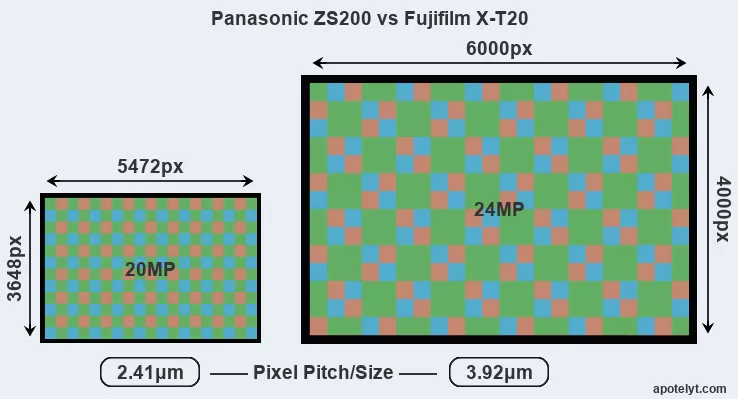
Consistent information on actual sensor performance is available from DXO Mark for many cameras. This service assesses and scores the color depth ("DXO Portrait"), dynamic range ("DXO Landscape"), and low-light sensitivity ("DXO Sports") of camera sensors, and also publishes an overall camera score. The table below summarizes the physical sensor characteristics and sensor quality findings and compares them across a set of similar cameras.

| Camera Model |
Sensor Class |
Resolution (MP) |
Horiz. Pixels |
Vert. Pixels |
Video Format |
DXO Portrait |
DXO Landscape |
DXO Sports |
DXO Overall |
||
|---|---|---|---|---|---|---|---|---|---|---|---|
| 1. | Panasonic ZS200 | 1-inch | 20.0 | 5472 | 3648 | 4K/30p | 22.0 | 12.2 | 449 | 64 | |
| 2. | Fujifilm X-T20 | APS-C | 24.0 | 6000 | 4000 | 4K/30p | 23.9 | 13.2 | 1704 | 81 | |
| 3. | Canon G5 X | 1-inch | 20.0 | 5472 | 3648 | 1080/60p | 21.4 | 12.3 | 471 | 62 | |
| 4. | Canon G5 X Mark II | 1-inch | 20.0 | 5472 | 3648 | 4K/30p | 22.2 | 12.4 | 583 | 65 | |
| 5. | Canon G7 X | 1-inch | 20.0 | 5472 | 3648 | 1080/60p | 23.0 | 12.7 | 556 | 71 | |
| 6. | Canon G7 X Mark II | 1-inch | 20.0 | 5472 | 3648 | 1080/60p | 21.8 | 11.9 | 260 | 62 | |
| 7. | Canon G7 X Mark III | 1-inch | 20.0 | 5472 | 3648 | 4K/30p | 22.2 | 12.4 | 583 | 65 | |
| 8. | Fujifilm X-A5 | APS-C | 24.0 | 6000 | 4000 | 4K/15p | 24.0 | 13.3 | 1800 | 82 | |
| 9. | Fujifilm X-E3 | APS-C | 24.0 | 6000 | 4000 | 4K/30p | 23.9 | 13.3 | 1764 | 82 | |
| 10. | Fujifilm X-T10 | APS-C | 16.0 | 4896 | 3264 | 1080/60p | 23.7 | 12.9 | 1546 | 79 | |
| 11. | Fujifilm X-T30 | APS-C | 26.0 | 6240 | 4160 | 4K/30p | 24.1 | 13.5 | 1895 | 83 | |
| 12. | Fujifilm X-T100 | APS-C | 24.0 | 6000 | 4000 | 4K/15p | 24.0 | 13.4 | 1829 | 83 | |
| 13. | Panasonic FZ1000 | 1-inch | 20.0 | 5472 | 3648 | 4K/30p | 22.1 | 11.7 | 517 | 64 | |
| 14. | Panasonic FZ1000 II | 1-inch | 20.0 | 5472 | 3648 | 4K/30p | 22.1 | 12.4 | 546 | 65 | |
| 15. | Panasonic GX9 | Four Thirds | 20.2 | 5184 | 3888 | 4K/30p | 23.1 | 12.8 | 1163 | 74 | |
| 16. | Panasonic LX10 | 1-inch | 20.0 | 5472 | 3648 | 4K/30p | 22.8 | 12.5 | 581 | 70 | |
| 17. | Panasonic ZS100 | 1-inch | 20.0 | 5472 | 3648 | 4K/30p | 22.8 | 12.5 | 559 | 70 | |
| Note: DXO values in italics represent estimates based on sensor size and age. | |||||||||||
Many modern cameras are not only capable of taking still images, but also of capturing video footage. Both cameras under consideration have a sensor with sufficiently fast read-out times for moving pictures, and both provide the same movie specifications (4K/30p).
Feature comparison
Apart from body and sensor, cameras can and do differ across a variety of features. The two cameras under review are similar with respect to both having an electronic viewfinder. However, the one in the X-T20 offers a slightly higher resolution than the one in the ZS200 (2360k vs 2330k dots). The table below summarizes some of the other core capabilities of the Panasonic ZS200 and Fujifilm X-T20 in connection with corresponding information for a sample of similar cameras.

| Camera Model |
Viewfinder (Type or 000 dots) |
Control Panel (yes/no) |
LCD Specifications (inch/000 dots) |
LCD Attach- ment |
Touch Screen (yes/no) |
Max Shutter Speed * |
Max Shutter Flaps * |
Built-in Flash (yes/no) |
Built-in Image Stab |
||
|---|---|---|---|---|---|---|---|---|---|---|---|
| 1. | Panasonic ZS200 | 2330 | n | 3.0 / 1240 | fixed | Y | 1/2000s | 10.0/s | Y | Y | |
| 2. | Fujifilm X-T20 | 2360 | n | 3.0 / 1040 | tilting | Y | 1/4000s | 8.0/s | Y | n | |
| 3. | Canon G5 X | 2360 | n | 3.0 / 1040 | swivel | Y | 1/2000s | 5.9/s | Y | Y | |
| 4. | Canon G5 X Mark II | 2360 | n | 3.0 / 1040 | tilting | Y | 1/2000s | 30/s | Y | Y | |
| 5. | Canon G7 X | none | n | 3.0 / 1040 | tilting | Y | 1/2000s | 6.5/s | Y | Y | |
| 6. | Canon G7 X Mark II | none | n | 3.0 / 1040 | tilting | Y | 1/2000s | 8.0/s | Y | Y | |
| 7. | Canon G7 X Mark III | none | n | 3.0 / 1040 | tilting | Y | 1/2000s | 30/s | Y | Y | |
| 8. | Fujifilm X-A5 | none | n | 3.0 / 1040 | tilting | Y | 1/4000s | 6.0/s | Y | n | |
| 9. | Fujifilm X-E3 | 2360 | n | 3.0 / 1040 | fixed | Y | 1/4000s | 8.0/s | n | n | |
| 10. | Fujifilm X-T10 | 2360 | n | 3.0 / 920 | tilting | n | 1/4000s | 8.0/s | Y | n | |
| 11. | Fujifilm X-T30 | 2360 | n | 3.0 / 1040 | tilting | Y | 1/4000s | 8.0/s | Y | n | |
| 12. | Fujifilm X-T100 | 2360 | n | 3.0 / 1040 | swivel | Y | 1/4000s | 6.0/s | Y | n | |
| 13. | Panasonic FZ1000 | 2359 | n | 3.0 / 921 | swivel | n | 1/4000s | 12.0/s | Y | Y | |
| 14. | Panasonic FZ1000 II | 2360 | n | 3.0 / 1240 | swivel | Y | 1/4000s | 12.0/s | Y | Y | |
| 15. | Panasonic GX9 | 2760 | n | 3.0 / 1240 | tilting | Y | 1/4000s | 9.0/s | Y | Y | |
| 16. | Panasonic LX10 | none | n | 3.0 / 1040 | tilting | Y | 1/4000s | 10.0/s | Y | Y | |
| 17. | Panasonic ZS100 | 1166 | n | 3.0 / 1040 | fixed | Y | 1/2000s | 10.0/s | Y | Y | |
| Note: *) Information refers to the mechanical shutter, unless the camera only has an electronic one. | |||||||||||
The reported shutter speed information refers to the use of the mechanical shutter. Yet, some cameras only have an electronic shutter, while others have an electronic shutter in addition to a mechanical one. In fact, both cameras under consideration feature an electronic shutter, which makes completely silent shooting possible. However, this mode is less suitable for photographing moving objects (risk of rolling shutter) or shooting under artificial light sources (risk of flickering).
The Panasonic ZS200 and the Fujifilm X-T20 both have an intervalometer built-in. This enables the photographer to capture time lapse sequences, such as flower blooming, a sunset or moon rise, without purchasing an external camera trigger and related software.
Concerning the storage of imaging data, both the ZS200 and the X-T20 write their files to SDXC cards. Both cameras can use UHS-I cards, which provide for Ultra High Speed data transfer of up to 104 MB/s.
Connectivity comparison
For some imaging applications, the extent to which a camera can communicate with its environment can be an important aspect in the camera decision process. The table below provides an overview of the connectivity of the Panasonic Lumix DC-ZS200 and Fujifilm X-T20 and, in particular, the interfaces the cameras (and selected comparators) provide for accessory control and data transfer.

| Camera Model |
Hotshoe Port |
Internal Mic / Speaker |
Microphone Port |
Headphone Port |
HDMI Port |
USB Port |
WiFi Support |
NFC Support |
Bluetooth Support |
||
|---|---|---|---|---|---|---|---|---|---|---|---|
| 1. | Panasonic ZS200 | - | stereo / mono | - | - | micro | 2.0 | Y | - | Y | |
| 2. | Fujifilm X-T20 | Y | stereo / mono | Y | - | micro | 2.0 | Y | - | - | |
| 3. | Canon G5 X | Y | stereo / mono | - | - | mini | 2.0 | Y | Y | - | |
| 4. | Canon G5 X Mark II | - | stereo / mono | - | - | micro | 3.1 | Y | - | Y | |
| 5. | Canon G7 X | - | stereo / mono | - | - | micro | 2.0 | Y | Y | - | |
| 6. | Canon G7 X Mark II | - | stereo / mono | - | - | micro | 2.0 | Y | Y | - | |
| 7. | Canon G7 X Mark III | - | stereo / mono | Y | - | micro | 3.1 | Y | - | Y | |
| 8. | Fujifilm X-A5 | Y | stereo / mono | Y | - | micro | 2.0 | Y | - | Y | |
| 9. | Fujifilm X-E3 | Y | stereo / mono | Y | - | micro | 2.0 | Y | - | Y | |
| 10. | Fujifilm X-T10 | Y | stereo / mono | Y | - | micro | 2.0 | Y | - | - | |
| 11. | Fujifilm X-T30 | Y | stereo / mono | Y | - | micro | 3.1 | Y | - | Y | |
| 12. | Fujifilm X-T100 | Y | stereo / mono | Y | - | micro | 2.0 | Y | - | Y | |
| 13. | Panasonic FZ1000 | Y | stereo / mono | Y | - | micro | 2.0 | Y | Y | - | |
| 14. | Panasonic FZ1000 II | Y | stereo / mono | Y | - | micro | 2.0 | Y | - | Y | |
| 15. | Panasonic GX9 | Y | stereo / mono | - | - | micro | 2.0 | Y | - | Y | |
| 16. | Panasonic LX10 | - | stereo / mono | - | - | micro | 2.0 | Y | - | - | |
| 17. | Panasonic ZS100 | - | stereo / mono | - | - | micro | 2.0 | Y | - | - |
It is notable that the X-T20 has a microphone port, which can help to improve the quality of audio recordings by attaching an external microphone. The ZS200 does not feature such a mic input.
The ZS200 is a recent model that features in the current product line-up of Panasonic. In contrast, the X-T20 has been discontinued (but can be found pre-owned on ebay). As a replacement in the same line of cameras, the X-T20 was succeeded by the Fujifilm X-T100. Further information on the features and operation of the ZS200 and X-T20 can be found, respectively, in the Panasonic ZS200 Manual (free pdf) or the online Fujifilm X-T20 Manual.
Review summary
So what is the bottom line? Which of the two cameras – the Panasonic ZS200 or the Fujifilm X-T20 – has the upper hand? Is one clearly better than the other? Below is a summary of the relative strengths of each of the two contestants.

Advantages of the Panasonic Lumix DC-ZS200:
- Better moiré control: Has an anti-alias filter to avoid artificial patterns to appear in images.
- More detailed LCD: Has a higher resolution rear screen (1240k vs 1040k dots).
- Faster burst: Shoots at higher frequency (10 vs 8 flaps/sec) to capture the decisive moment.
- Ready to shoot: Has a lens built-in, whereas the X-T20 requires a separate lens.
- More compact: Is smaller (111x65mm vs 118x83mm) and thus needs less room in the bag.
- Less heavy: Is lighter even though it comes with a built-in lens (unlike the X-T20).
- Sharper images: Has hand-shake reducing image stabilization built-in.
- Easier wireless transfer: Supports Bluetooth for image sharing without cables.
- More affordable: Was introduced at a lower price, despite coming with a built-in lens.
- More modern: Is somewhat more recent (announced 1 year after the X-T20).

Reasons to prefer the Fujifilm X-T20:
- More detail: Has more megapixels (24 vs 20MP), which boosts linear resolution by 10%.
- Maximized detail: Lacks an anti-alias filter to exploit the sensor's full resolution potential.
- Better image quality: Features bigger pixels on a larger sensor for higher quality imaging.
- Richer colors: The pixel size advantage translates into images with better, more accurate colors.
- More dynamic range: Larger pixels capture a wider spectrum of light and dark details.
- Better low-light sensitivity: Larger pixels means good image quality even under poor lighting.
- Better live-view autofocus: Features on-sensor phase-detection for more confident autofocus.
- Better sound: Can connect to an external microphone for higher quality sound recording.
- Larger viewfinder image: Features a viewfinder with a higher magnification (0.62x vs 0.53x).
- More flexible LCD: Has a tilting screen for odd-angle shots in landscape orientation.
- Faster shutter: Has higher mechanical shutter speed (1/4000s vs 1/2000s) to freeze action.
- More flexible: Takes interchangeable lenses and can thus be used with specialty optics.
- Better lighting: Features a hotshoe and can thus hold and trigger an external flash gun.
- More heavily discounted: Has been on the market for longer (launched in January 2017).
If the count of individual advantages (bullet points above) is taken as a guide, the X-T20 is the clear winner of the contest (14 : 10 points). However, the relative importance of the various individual camera aspects will vary according to personal preferences and needs, so that you might like to apply corresponding weights to the particular features before making a decision on a new camera. A professional sports photographer will view the differences between cameras in a way that diverges from the perspective of a street photog, and a person interested in family portraits has distinct needs from a landscape shooter. Hence, the decision which camera is best and worth buying is often a very personal one.
How about other alternatives? Do the specifications of the Panasonic ZS200 and the Fujifilm X-T20 place the cameras among the top in their class? Find out in the latest Best Superzoom Camera and Best Mirrorless Interchangeable Lens Camera listings whether the two cameras rank among the cream of the crop.
In any case, while the comparison of technical specifications can provide a useful overview of the capabilities of different cameras, it remains partial and cannot reveal, for example, the shooting experience and imaging performance when actually working with the ZS200 or the X-T20. User reviews, such as those found at amazon, can sometimes inform about these issues, but such feedback is often incomplete, inconsistent, and biased.
Expert reviews
This is why expert reviews are important. The following table reports the overall ratings of the cameras as published by some of the major camera review sites (amateurphotographer [AP], cameralabs [CL], digitalcameraworld [DCW], dpreview [DPR], ephotozine [EPZ], photographyblog [PB]). As can be seen, the professional reviewers agree in many cases on the quality of different cameras, but sometimes their assessments diverge, reinforcing the earlier point that a camera decision is often a very personal choice.

| Camera Model |
AP score |
CL score |
DCW score |
DPR score |
EPZ score |
PB score |
Camera Launch |
Launch Price (USD) |
Street Price |
||
|---|---|---|---|---|---|---|---|---|---|---|---|
| 1. | Panasonic ZS200 | .. | + + | 4.5/5 | 81/100 | 4.5/5 | 4.5/5 | Feb 2018 | 799 | amazon.com | |
| 2. | Fujifilm X-T20 | 5/5 | + + | 5/5 | 82/100 | 5/5 | 4.5/5 | Jan 2017 | 899 | ebay.com | |
| 3. | Canon G5 X | 5/5 | + + | .. | 78/100 | 4.5/5 | 4.5/5 | Oct 2015 | 799 | ebay.com | |
| 4. | Canon G5 X Mark II | 4/5 | + | 4/5 | 82/100 | .. | 4/5 | Jul 2019 | 899 | ebay.com | |
| 5. | Canon G7 X | 4/5 | + + | .. | 77/100 | 4.5/5 | 4.5/5 | Sep 2014 | 699 | ebay.com | |
| 6. | Canon G7 X Mark II | 4.5/5 | + + | .. | 81/100 | 4.5/5 | 4.5/5 | Feb 2016 | 699 | ebay.com | |
| 7. | Canon G7 X Mark III | .. | + + | 4/5 | 81/100 | 4/5 | .. | Jul 2019 | 749 | amazon.com | |
| 8. | Fujifilm X-A5 | .. | + | 4.1/5 | .. | 4/5 | 3.5/5 | Jan 2018 | 399 | ebay.com | |
| 9. | Fujifilm X-E3 | 4.5/5 | + | 4.5/5 | 84/100 | 4.5/5 | 4.5/5 | Sep 2017 | 899 | ebay.com | |
| 10. | Fujifilm X-T10 | 4.5/5 | + + | .. | 80/100 | 5/5 | 5/5 | May 2015 | 799 | ebay.com | |
| 11. | Fujifilm X-T30 | 5/5 | + + | 5/5 | 84/100 | 4.5/5 | 4.5/5 | Feb 2019 | 899 | ebay.com | |
| 12. | Fujifilm X-T100 | 4/5 | + | 4.5/5 | 79/100 | 4/5 | 4.5/5 | May 2018 | 599 | ebay.com | |
| 13. | Panasonic FZ1000 | 4/5 | + + | .. | 82/100 | 4.5/5 | 4.5/5 | Jun 2014 | 899 | ebay.com | |
| 14. | Panasonic FZ1000 II | .. | .. | .. | 83/100 | 4.5/5 | 4.5/5 | Feb 2019 | 899 | amazon.com | |
| 15. | Panasonic GX9 | 4/5 | + | 4/5 | 84/100 | 4.5/5 | 4.5/5 | Feb 2018 | 849 | ebay.com | |
| 16. | Panasonic LX10 | .. | + + | 4/5 | 81/100 | 4/5 | 4.5/5 | Sep 2016 | 699 | amazon.com | |
| 17. | Panasonic ZS100 | 4.5/5 | + + | .. | 82/100 | 4.5/5 | 4.5/5 | Jan 2016 | 699 | ebay.com | |
| Note: (+ +) highly recommended; (+) recommended; (o) reviewed; (..) not available. | |||||||||||
The above review scores should be interpreted with care, though. The ratings were established in reference to similarly priced cameras that were available in the market at the time of the review. Hence, a score should always be seen in the context of the camera's market launch date and its price, and comparisons of ratings among very different cameras or across long time periods have little meaning. Also, please note that some of the review sites have changed their methodology and reporting over time.

Check ZS200 price at
amazon.com

Check X-T20 offers at
ebay.com
Other camera comparisons
Did this review help to inform your camera decision process? In case you are interested in seeing how other cameras pair up, just make a corresponding selection in the search boxes below. There is also a set of direct links to comparison reviews that other users of the CAM-parator app explored.
- Canon 450D vs Fujifilm X-T20
- Canon G3 X vs Fujifilm X-T20
- Fujifilm X-T20 vs Fujifilm X70
- Fujifilm X-T20 vs Nikon D4
- Fujifilm X-T20 vs Panasonic GH1
- Fujifilm X-T20 vs Sony A77
- Leica M10 vs Panasonic ZS200
- Nikon Z6 II vs Panasonic ZS200
- Panasonic G95 vs Panasonic ZS200
- Panasonic ZS200 vs Pentax KP
- Panasonic ZS200 vs Sony A6600
- Panasonic ZS200 vs Sony RX1
Specifications: Panasonic ZS200 vs Fujifilm X-T20
Below is a side-by-side comparison of the specs of the two cameras to facilitate a quick review of their differences and common features.
| Camera Model | Panasonic ZS200 | Fujifilm X-T20 |
|---|---|---|
| Camera Type | Fixed lens compact camera | Mirrorless system camera |
| Camera Lens | 24-360mm f/3.3-6.4 | Fujifilm X mount lenses |
| Launch Date | February 2018 | January 2017 |
| Launch Price | USD 799 | USD 899 |
| Sensor Specs | Panasonic ZS200 | Fujifilm X-T20 |
| Sensor Technology | CMOS | CMOS |
| Sensor Format | 1" Sensor | APS-C Sensor |
| Sensor Size | 13.2 x 8.8 mm | 23.6 x 15.6 mm |
| Sensor Area | 116.16 mm2 | 368.16 mm2 |
| Sensor Diagonal | 15.9 mm | 28.3 mm |
| Crop Factor | 2.7x | 1.5x |
| Sensor Resolution | 20 Megapixels | 24 Megapixels |
| Image Resolution | 5472 x 3648 pixels | 6000 x 4000 pixels |
| Pixel Pitch | 2.41 μm | 3.92 μm |
| Pixel Density | 17.18 MP/cm2 | 6.52 MP/cm2 |
| Moiré control | Anti-Alias filter | no AA filter |
| Movie Capability | 4K/30p Video | 4K/30p Video |
| ISO Setting | 125 - 12,800 ISO | 200 - 12,800 ISO |
| ISO Boost | 80 - 25,600 ISO | 100 - 51,200 ISO |
| Image Processor | Venus | X-Processor Pro2 |
| Screen Specs | Panasonic ZS200 | Fujifilm X-T20 |
| Viewfinder Type | Electronic viewfinder | Electronic viewfinder |
| Viewfinder Field of View | 100% | 100% |
| Viewfinder Magnification | 0.53x | 0.62x |
| Viewfinder Resolution | 2330k dots | 2360k dots |
| LCD Framing | Live View | Live View |
| Rear LCD Size | 3.0inch | 3.0inch |
| LCD Resolution | 1240k dots | 1040k dots |
| LCD Attachment | Fixed screen | Tilting screen |
| Touch Input | Touchscreen | Touchscreen |
| Shooting Specs | Panasonic ZS200 | Fujifilm X-T20 |
| Focus System | Contrast-detect AF | On-Sensor Phase-detect |
| Manual Focusing Aid | Focus Peaking | Focus Peaking |
| Max Shutter Speed (mechanical) | 1/2000s | 1/4000s |
| Continuous Shooting | 10 shutter flaps/s | 8 shutter flaps/s |
| Electronic Shutter | up to 1/16000s | up to 1/32000s |
| Time-Lapse Photography | Intervalometer built-in | Intervalometer built-in |
| Image Stabilization | In-body stabilization | Lens stabilization only |
| Fill Flash | Built-in Flash | Built-in Flash |
| Storage Medium | SDXC cards | SDXC cards |
| Single or Dual Card Slots | Single card slot | Single card slot |
| UHS card support | UHS-I | UHS-I |
| Connectivity Specs | Panasonic ZS200 | Fujifilm X-T20 |
| External Flash | no Hotshoe | Hotshoe |
| USB Connector | USB 2.0 | USB 2.0 |
| HDMI Port | micro HDMI | micro HDMI |
| Microphone Port | no MIC socket | External MIC port |
| Wifi Support | Wifi built-in | Wifi built-in |
| Bluetooth Support | Bluetooth built-in | no Bluetooth |
| Body Specs | Panasonic ZS200 | Fujifilm X-T20 |
| Battery Type | Panasonic DMW-BLG10 | Fujifilm NP-W126S |
| Battery Life (CIPA) | 370 shots per charge | 350 shots per charge |
| In-Camera Charging | USB charging | USB charging |
| Body Dimensions |
111 x 65 x 45 mm (4.4 x 2.6 x 1.8 in) |
118 x 83 x 41 mm (4.6 x 3.3 x 1.6 in) |
| Camera Weight | 340 g (12.0 oz) | 383 g (13.5 oz) |

Check ZS200 price at
amazon.com

Check X-T20 offers at
ebay.com
Did you notice an error on this page? If so, please get in touch, so that we can correct the information.

